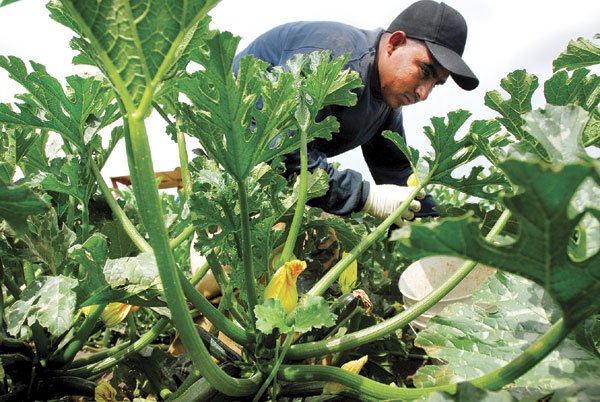South County farmers might get a long-awaited bite of the Farm
Bill, the $300-billion behemoth that sculpts U.S. agriculture twice
a decade, if a California Congressman’s provision survives the
House and Senate.
Gilroy – South County farmers might get a long-awaited bite of the Farm Bill, the $300-billion behemoth that sculpts U.S. agriculture twice a decade, if a California Congressman’s provision survives the House and Senate. But billions more are still earmarked for cotton, corn and other “program crops,” in a system intended to stabilize U.S. agriculture, now under fire for waste.
For decades, the Farm Bill has funneled billions of dollars to a select few crops, largely ignoring the specialty crops that sprout from South County fields. Cherry grower Ralph Santos shrugs when asked about the 2007 bill; Uesugi Farms’ Pete Aiello has no idea how to apply for a subsidy.
“We’ve never been paid one red cent from the government not to grow something,” said Aiello, whose farm grows bell peppers, cabbage and strawberries, none of which attract government funds. “We’ve never even filed for one.”
Only 9 percent of California farmers get government money – and in South County, the numbers may be even slimmer, due to the crops that fill Gilroy soil. Farmers who harvest strawberries, apricots, lettuce and other specialty crops get payments for conservation and disaster relief, but not for their crops.
“In past Farm Bills, although specialty crops are 50 percent of the market value of the crops produced in this country, they only got 5 percent of the Farm Bill money,” said Jamie McInerney, communications director for Rep. Dennis Cardoza (D-Atwater.) “Obviously, that’s crazy.”
Meanwhile, billions of dollars bolster cotton, corn, wheat and soy, driving down prices for “commodity crops.” The more farmers plant, the more cash they get. The system originated during the Depression, and was intended to support struggling small farmers and stabilize domestic food supplies.
But critics say the system fattens big farms at the expense of small ones and gluts foreign markets with bottom-dollar cotton – a practice the World Trade Organization has ruled illegal. The USDA itself has recognized that commodity subsidies have shifted dollars to larger, wealthier farms. In 2003, half of commodity payments went to households earning $75,772 or more, according to a 2006 USDA brief.
“Enough is enough,” said Sandra Schubert, director of government affairs for Environmental Working Group, a nonprofit that tracks farm subsidies. She noted that Florida businessman Maurice Wilder, whose assets are valued at $500 million, has collected more than $3 million in farm payments in just three years. “We means-test for food stamps. Why aren’t we means-testing multi-millionaires?”
Loopholes allow farmers to apply through multiple entities, skirting limits on government payments. Even death is no match for farm subsidies: More than 170,000 dead farmers received a total of $1.1 billion in payments between 1999 and 2005, according to a report released Monday by Congress’ Government Accountability Office.
“Our policies favor the big players,” said Mike Monroe, owner of the People and Planet store in Morgan Hill, which specializes in Fair Trade products from coffee to shampoo. Monroe, a St. Mary’s parishioner, has editorialized against farm subsidies in the Valley Catholic, arguing that the payments cripple foreign growers. “Even in the U.S., the subsidies aren’t evenly applied.”
Midwest farmers dwarf
Gilroy’s recipients
According to the Environmental Working Group, the bulk of Gilroy farm payments have gone to two hay farmers: Albert Silva, a Gilroyan who farms in San Benito County, and G&K Farms, owned by Gary Morton and Kip Brundage. Nearly one-third of Gilroy’s farm payments went to Silva between 1995 and 2005 – a total of $740,852.69, most of it in crop payments for corn and wheat. G&K received $205,495, mostly in wheat subsidies.
“The programs have been generally effective in keeping the farm base together,” said Kip Brundage, the owner of G&K Farms and a former USDA employee. “But any time the government creates a program, there are holes.”
Even Silva and Brundage were awarded far less than farmers in the Midwest and Texas, where the top recipient got more than $8 million in government payments between 1995 and 2005. Though California outstripped every other state in agricultural production in 2005 and outproduces the 22 lowest-producing states combined, it received less than 40 percent of the money siphoned toward the lowly 22, landing it 10th position among subsidy-receiving states. Frustrated farmers say it’s not just a matter of loopholes.
“Wheat and cotton and dairy get support, because their senators make sure it happens,” said Jan Garrod, president of the Santa Clara County Farm Bureau. “We just don’t have the clout that the Midwest states have.”
Commodity-crop states such as Texas and Kansas have historically dominated the House Agriculture committee, said Schubert. It’s no surprise, she remarked, that subsidies map closely along their Congressional districts.
“When the last Farm Bill came up” in 2002, “there were only 11 [of 53] California Congressional delegates that voted for it,” added A.J. Kawamura, California’s Secretary of Food and Agriculture. “It didn’t have much in it that benefited California.”
One Congressman aims to change that, rerouting Farm Bill funds to fruit and vegetable growers. The Eat Healthy America Act, proposed by Congressman Cardoza, would shell out $1.6 billion over five years for programs benefiting specialty crops, more than triple the funds originally proposed. McInerney, Rep. Cardoza’s spokesman, hastens to distinguish the programs from a subsidy, which directly affects a crop’s price: The funds are designated for research, conservation and nutrition programs such as the Fruit and Vegetable Snack Program, a $350 million effort to ensure schools a fresh supply of local produce, and $32 million to promote farmers’ markets.
“This is a landmark change,” said McInerney. “Finally, we have a Farm Bill for the 21st century.”
More dramatic reform
needed, some say
But for some, California’s slice of the subsidy pie is still too small. Cotton, corn and grains will still garner 25 times as much money as specialty crops, even with Cardoza’s proposal, noted the California Coalition for Food and Farming, a Watsonville-based group pushing for Farm Bill reform. Other Farm Bill provisions would lift the limit on program subsidies from $80,000 to $120,000 per year, allowing big growers to milk the system for even higher sums.
“This translates into a continuation of a massive imbalance in Farm Bill spending that is not in the best interest of our taxpayers, nor the majority of farmers,” wrote Kari Hamerschlag, CCFF’s police director, in a letter to House Speaker Nancy Pelosi (D-San Francisco).
The Farm Bureau is agitating for more conservation dollars to wean farmers off fossil fuels and minimize erosion, such as the Environmental Quality Incentives Program. The Farm Bureau’s Garrod complained that the existing program is bureaucratic and molasses-slow, and California’s cut of EQIP funds is dwarfed by that of Texas, which produces only 59 percent compared to California. Overall, conservation gets a far smaller chunk of change: Six times as much money was funneled to commodity subsidies as conservation programs from 1995 to 2005.
“It’s all talk, no substance, in the current Farm Bill,” said EWG’s Schubert. “There’s no reform coming from there.”
EWG backs a provision that would cull $10 billion from commodity subsidies to support conservation and rural development, the Fairness in Farm and Food Policy amendment, sponsored by Representatives Jeff Flake (D-Arizona) and Ron Kind (D-Wisconsin.) That, said Schubert, would benefit the small family farmers the Farm Bill is supposed to serve.
Meanwhile, the Farm Bill crawls through committee after committee, picking up support – sometimes from unlikely fans.
“I support commodities to help those program crops,” said Tim Chiala, manager of George Chiala Farms, which grows garlic and jalapeño peppers in Morgan Hill. Between 1995 and 2005, his farm hasn’t gotten a dollar of federal money. “It helps out my industry – specialty crops – by keeping people out of it.”














